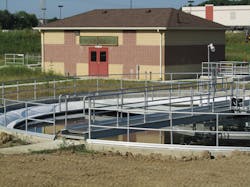Breaking Traditions - Township Embraces New Wastewater Treatment Method
When opportunity knocks, it’s usually a good idea to answer. For Clay Township Regional Waste District, welcoming that opportunity meant breaking away from 25 years of tradition and embracing a new, cost-effective wastewater treatment method.
Located immediately north of Indianapolis, Indiana, and serving fast-growing suburbs in Hamilton and Boone counties, Clay Township Regional Waste District’s (CTRWD) wastewater treatment plant was beginning to reach its capacity and would be in need of expansion within the next five years. To meet the growing demands of the surrounding area, CTRWD, with assistance from Strand Associates Inc., started expanding its plant.
However, upon review of the plant, the project team noticed it was a prime candidate for biological phosphorus removal (BPR), a method scarcely used in Indiana.
Since the early 1990s, Indiana lake dischargers had effluent phosphorus limits that were mostly met through chemical treatment. For the next 25 years, the way to deal with phosphorus was simple: chemical treatment, in this case using aluminum sulfate (alum). However, while chemical treatment works and represents a reasonable initial investment, the long-term costs of handling and disposing of the resulting sludge, as well as continually adding chemicals, becomes increasingly less cost effective. Rather than keep with tradition, CTRWD decided to break from the mold and capitalize on this new opportunity.
BPR works by first creating a zone without oxygen (anaerobic). This anaerobic zone contains organic matter that, in the absence of oxygen, ferments into volatile fatty acids (VFAs). In addition to the organic matter, phosphorus-accumulating organisms (PAOs) are also present in the anaerobic zone. Without oxygen, these PAOs consume VFAs to receive carbon and in the process metabolize and emit phosphorus. The PAOs are then moved to an aerobic (with oxygen) zone where they are able to ingest and store a higher level of phosphorus and multiply because of the conditioning received in the anaerobic zone. Simply put, the anaerobic “training tank” enhances the capacity of PAOs to store phosphorus in an area with oxygen. These PAOs then form masses or flocs of waste activated sludge (WAS). A portion of that sludge is sent out of the treatment train system and the remaining amount is returned as return activated sludge (RAS) to replenish the depleted supply of PAOs in the anaerobic zone and begin the treatment process all over again.
Prior to the expansion, incoming wastewater (influent) was transferred from CTRWD’s pretreatment building to either the Orbal oxidation ditch or the vertical loop reactor (VLR) and alum was added just prior to the reactors. The alum attracts phosphorus and forms a floc of sludge, which is sent to the secondary clarifiers, allowed to settle, and subsequently wasted out of the system. The process begins again with new influent and more alum added to the VLR and Orbal oxidation ditch to facilitate chemical treatment.
However, with BPR, alum is no longer added to the VLR. Instead, the VLR’s anaerobic zone was increased to facilitate BPR. While chemical treatment is still used with the Orbal oxidation ditch, the overall amount of added alum has been significantly reduced. The team decided to forgo adding BPR to the Orbal oxidation ditch, as the expansion plan already called for construction on the VLR.
Thus, the team was able to add a cost-effective treatment alternative without additional construction. In addition, the VLR and Orbal oxidation ditch use a single sludge system where the RAS is mixed prior to returning to the respective tanks and the BPR process should promote enough PAO growth for the reactors.
While outfitting the VLR for the new treatment represented a higher preliminary investment than just keeping with the traditional chemical addition, the cost of adding BPR to the $5.3 million expansion project was only 2 percent of the total project cost. Also, the long-term maintenance of BPR is more cost effective since the process continues to recycle itself again and again without the need for additional materials. With the addition of BPR, CTRWD has been able to reduce the amount of alum added by more than 70 percent.
Many factors made the plant a prime candidate for BPR. For one thing, the incoming wastewater was conveyed through long force mains, giving the organic materials more time to ferment and develop VFAs. Increasing the amount of VFAs increased the amount of available carbon or “food” for the PAOs, thereby, enhancing the organisms “training.” In addition, the plant’s influent wastewater strength was higher than normal, which, again, promoted the amount of microorganisms available to facilitate BPR.
The project was completed in 2014, with a corresponding expansion of the aerobic digesters completed in 2015, and has fulfilled CTRWD’s primary goal of expanding the design average flow of the plant from 2.55 to 3.05 mgd and the peak hourly flow from 8.1 to 15.3 mgd to more effectively handle wet weather flow.
By embracing forward-thinking treatment options and answering the call of opportunity, CTRWD has not only expanded its plant but also welcomed a viable, cost-effective treatment option. CTRWD’s expansion project took the opportunity to break away from tradition and embrace cost-effective measures that can now serve as a model for future BPR installations throughout Indiana.
Established in 1946, Strand Associates is a dynamic, multidisciplinary engineering firm serving the needs of public and private sector clients throughout the United States. To learn more, visit www.strand.com.
More WaterWorld Current Issue Articles
More WaterWorld Archives Issue Articles

